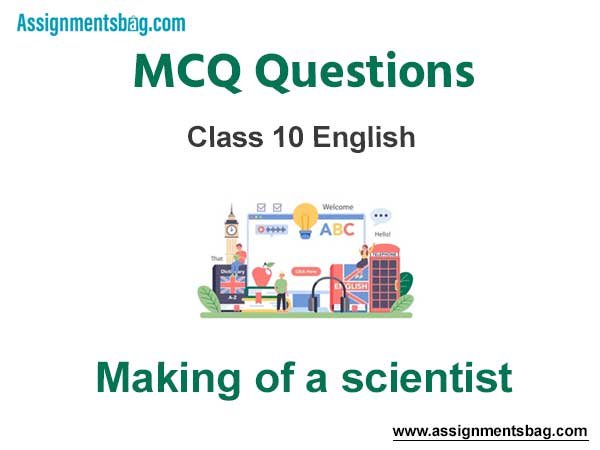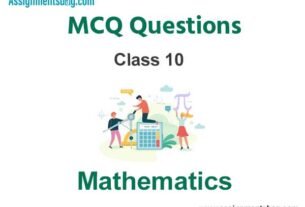Please refer to MCQ Questions Chapter 11 Making of a scientist Class 10 English with answers provided below. These multiple-choice questions have been developed based on the latest NCERT book for class 10 English issued for the current academic year. We have provided MCQ Questions for Class 10 English for all chapters on our website. Students should learn the objective based questions for Chapter 11 Making of a scientist in Class 10 English provided below to get more marks in exams.
Chapter 11 Making of a scientist MCQ Questions
Please refer to the following Chapter 11 Making of a scientist MCQ Questions Class 10 English with solutions for all important topics in the chapter.
MCQ Questions Answers for Chapter 11 Making of a scientist Class 10 English
Question. What did he realise was necessary for winning a prize at the fair?
A) display
B) experiment
C) all of the above
D) none of the above
Answer
B
Question. Name Richard’s college room mate
A) John
B) James
C) Jack
D) Jeff
Answer
A
Question. Who is the writer of the story “The Making of a Scientist”?
A) HG Wells
B) Robert W. Peterson
C) Ruskin Bond
D) Guy De Maupassant
Answer
B
Question. What did Richard’s dad do?
A) scientist
B) doctor
C) he was dead
D) teacher
Answer
C
Question. How did his mother help him?
A) took him on trips
B) bought him telescopes and microscopes
C) encouraged him to learn
D) all of the above
Answer
D
Question. What was he fond of in his childhood?
A) basketball
B) collecting things
C) baseball
D) none of the above
Answer
B
Question. Where did Richard grew up?
A) Pennsylvania
B) Chicago
C) New York
D) London
Answer
A
Question. How many gold spots were there on a Monarch pupa?
A) 10
B) 15
C) 11
D) 12
Answer
D
Question. In which class was Ebright when he lost at the county science fair?
A) 5
B) 8
C) 7
D) 4
Answer
C
Question. “It was his fascination for _____ that opened the world of science to him.”
A) cats
B) dogs
C) birds
D) butterflies
Answer
D
Question. What was the purpose of the gold spots on the monarch pupa?
A) ornamental
B) secreted hormones
C) they were the breathing points
D) none of these
Answer
B
Question. He was an excellent _____
A) debator
B) scientist
C) photographer
D) all of the above
Answer
D
Question. At what age did he invent the theory on how cells work?
A) twenty
B) twenty one
C) twenty two
D) twenty four
Answer
C
Question. ____ is the blueprint of life
A) Oxygen
B) DNA
C) Cell
D) all of the above
Answer
B
Question. Name Ebright’s social science teacher.
A) Mr Weiherer
B) Dr Urquhart
C) James R Wong
D) Taplow
Answer
A
Ebright’s project was to see whether, in fact, birds would eat monarchs. He found that a starling would not eat ordinary bird food. It would eat all the monarchs it could get. (Ebright said later research by other people showed that viceroys probably do copy the monarch.) This project was placed first in the zoology division and third overall in the county science fair. In his second year in high school, Richard Ebright began the research that led to his discovery of an unknown insect hormone. lndirectly, it also led to his new theory on the life of cells.
Questions. What was the objective of the project?
(i) to test the theory that monarchs copied viceroy butterflies
(ii) to test the theory that viceroy butterflies copied monarchs
(iii) to know the purpose of twelve gold spots on monarch pupa
(iv) None of these
Answer
(ii)
Questions. In which class did he conduct this experiment?
(i) In class 6
(ii) In class 7
(iii) In class 8
(iv) In class 9
Answer
(iii)
Questions. What was Ebright able to prove?
(i) that the spots on monarch pupa helped in the development of the butterfly
(ii) that starlings avoided monarchs and went after viceroy butterflies
(iii) that starlings found monarchs edible and only ate monarchs as opposed to the theory
(iv) None of these
Answer
(iii)
Questions. Ebright was an excellent _______.
(i) debater
(ii) scientist
(iii) photographer
(iv) All of these
Answer
(iv)
Questions. Which butterflies were not eaten by birds?
(i) Viceroy
(ii) Monarch
(iii) Both (i) and (ii)
(iv) None of these
Answer
(ii)


